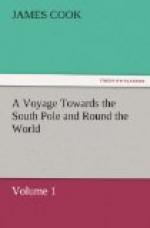1594 Sir Richard Hawkins.
Thus far I have thought it best not to interrupt the progress of discovery in the South Pacific Ocean, otherwise I should before have mentioned, that Sir Richard Hawkins in 1594, being about fifty leagues to the eastward of the river Plate, was driven by a storm to the eastward of his intended course, and when the weather grew moderate, steering towards the Straits of Magalhaens, he unexpectedly fell in with land, about sixty leagues of which he coasted, and has very particularly described. This he named Hawkins’s Maiden Land, in honour of his royal mistress, Queen Elizabeth, and says it lies some threescore leagues from the nearest part of South America.
1689 Strong.
This land was afterwards discovered to be two large islands, by Captain John Strong, of the Farewell, from London, who, in 1689, passed through the strait which divides the eastern from the western of those islands. To this strait he gave the name of Falkland’s Sound, in honour of his patron Lord Falkland; and the name has since been extended, through inadvertency, to the two islands it separates.
Having mentioned these islands, I will add, that future navigators will mis-spend their time, if they look for Pepy’s Island in 47 deg. S.; it being now certain, that Pepy’s Island is no other than these islands of Falkland.
1675 La Roche.
In April, 1675, Anthony la Roche, an English merchant, in his return from the South Pacific Ocean, where he had been on a trading voyage, being carried by the winds and currents, far to the east of Strait Le Maire, fell in with a coast, which may possibly be the same with that which I visited during this voyage, and have called the Island of Georgia.
Leaving this land, and sailing to the north, La Roche, in the latitude of 45 deg. S., discovered a large island, with a good port towards the eastern part, where he found wood, water, and fish.
1699 Halley.
In 1699, that celebrated astronomer, Dr Edmund Halley, was appointed to the command of his majesty’s ship the Paramour Pink, on an expedition for improving the knowledge of the longitude, and of the variation of the compass; and for discovering the unknown lands supposed to lie in the southern part of the Atlantic Ocean. In this voyage he determined the longitude of several places; and, after his return, constructed his variation-chart, and proposed a method of observing the longitude at sea, by means of the appulses and occultations of the fixed stars. But, though he so successfully attended to the two first articles of his instructions, he did not find any unknown southern land.
1721 Roggewein.




